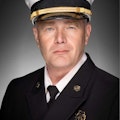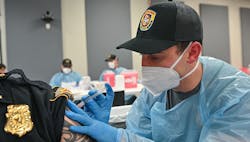The mission statement of every fire and EMS agency describes the responsibilities for prevention, education and response to a community that’s in need. Public health, according to the Centers for Disease Control and Prevention (CDC), is defined as the science of protecting and improving the health of people and their communities. These are two similarly defined missions of two separate city/county agencies that historically have been siloed, have competed for similar funding, and have argued, in many situations, that they are too underfunded and too understaffed to adequately meet the needs of the community that they serve.
Since 9/11, fire/EMS and public health have worked together to provide support and oversight of the cache of weapons of mass destruction medications that major cities received in preparation for future terrorism events. Today, forced to the table of cooperation because of the COVID-19 pandemic, the relationship that’s between public safety and public health has required a more collaborative approach to meet communities’ needs. The public has benefited from these relationships in nearly every community across the country.
The foundation exists
One of the primary areas of expertise in public health includes epidemiology support—particularly, the understanding of how disease affects a community regarding morbidity (the overall effect of a disease on a community) and mortality (the amount of death and disability that’s caused by the disease). This is counter to most 9-1-1 agencies that respond to requests for assistance from the public: solve the immediate need and transport to the appropriate care facility, if applicable. Nevertheless, fire/EMS has the medical training and education that’s necessary to enact the plans that are established by public health experts.
Although many communities just now are beginning to understand the synergistic relationship between public health and EMS, some communities have maximized relationships with public health for several years. The Columbus, OH, Division of Fire (CFD) has worked with the public health departments of Columbus County and Franklin County since 2014 regarding community responses to opiate overdose. Projects included community Naloxone programs, bystander CPR training (“See Something, Do Something”) and rapid response teams for opiate overdoses.
Capt. Matt Parrish, who facilitates the relationships in Columbus, explains that the old fire service mentality is the “doors go up and the truck goes out.” The new conversation is that community problems require community solutions, and social determinants of healthcare in a community must be approached with proactive, rather than reactive, thinking.
These types of collaborations require both agencies to have sufficient staff and particular areas of expertise that can be leveraged in support of a community. This was tested in 2015, when concerns of Ebola came to the United States. Working together, public health monitored inbound travelers from the affected regions while the CFD developed response plans to safely transport all surveilled patients who reported symptoms. The expertise of public health from a disease prevention and mitigation standpoint coupled with the expertise of a fire department EMS system from the out-of-hospital patient-care standpoint forced the partnership conversations. The decontamination and hazmat response expertise within the fire service benefited the safety of the community and kept both hospital and pre-hospital providers safe.
Each agency brought expertise to the table that the other was able to leverage to build a comprehensive response plan.
Learning more
Fast forward to 2020: The COVID-19 pandemic begins to take its toll. A coordinated team approach was put forth in Fort Worth, TX, and elsewhere, where fire and EMS providers, working alongside public health, stood up community testing, decontamination of reusable PPE, congregate living facility response and cleaning, monoclonal antibody treatment and vaccination sites.
As was the case in many other cities and municipalities throughout the country, meal-assistance programs in Fort Worth were affected negatively by reduced volunteerism because of the risk of community spread. The Fort Worth Fire Department (FWFD) stepped up to help to deliver meals. It used the opportunity of connecting with residents in difficult-to-reach populations to offer vaccines.
Fire departments are aligned strategically to support the mission of public health. The combination of out-of-hospital-provider medical knowledge, hazmat experience and consistent community presence makes public safety a great partner that should be leveraged by public health agencies. As well, fire and EMS are in the community every day and have the respect of the community. These members/providers are able to see the people’s living conditions and can identify food insecurity, unsafe sleeping conditions for infants, etc. Using electronic medical records, fire/EMS reporting data often is real-time, which offers early indications of problem areas for overdose, infant mortality, suicide, drowning, etc., all of which are determined to be public health problems.
The goal of any good public health program is to eradicate the disease. The healthcare prevention and education approach might be a new strategy; however, the fire service has a history of community risk reduction regarding fire safety education: The fire service has done amazing work over the years to eradicate significant fires in communities through education, prevention and building standards. The same strategies that have made the fire service successful in reducing the incidence of fires can and should be deployed in other cooperative programs that support public health in communities that we serve.
Maintain momentum
It’s imperative that we establish these relationships ahead of another community health emergency. If the fire service can communicate the problems that are seen in the community to public health, opportunities can be created to work together to have a positive effect in the communities that both agencies serve.
Fire service leaders shouldn’t assume that public health is aware of everything that the fire service has to offer from a risk-reduction and education perspective. As well, these same leaders shouldn’t wait quietly and expect the health department to find them. It’s up to every fire service leader to meet public health leaders. These relationships offer opportunities to talk about community issues and to build programs that take the care to the community, instead of always taking the community to the care. A smart way of going about it is to start with small projects that are data-driven and evidenced-based (think: bicycle helmet programs, drowning awareness, food insecurity, etc.). Discuss grant opportunities that help to fund or to expand the projects that you are determined to work on.
In the post-COVID world, the fire service must resist the loss of momentum that it gained in its relationship with public health. Fire service leadership should find members of their department who are relationship-oriented, then seek opportunities with public health agencies. Offer those agencies insight into your view of the needs in the community and your ongoing efforts and don’t be afraid to offer opportunities to work on community problems together. In addition, many public health agencies are clinical sites for local universities that have public health or social work programs. They might be able to maximize students’ experiences by partnering students with public safety organizations. This serves the dual purposes of enhancing the students’ learning and supplying the fire service with knowledgeable participants in the community work.
These public safety/public health partnerships also offer the opportunity to complete research and publish the findings. This is important information that other departments and municipalities can use to enhance their own community programs while validating the success of your program for future funding requests.
No time to waste
The needs of the community continue to change, and more attention is being placed today on public health than was the case in recent years. There will be budget conversations about the need to invest in public health after the glaring gaps that we have experienced in our communities with COVID-19.
The future of how the fire/EMS service fits into the future of healthcare and public health is now. It offers opportunities to change the response-only mindset of the 9-1-1 agencies to a more collaborative prevention, preparedness, interagency partnership that will maximize strategies for promoting healthier communities. Don’t miss the opportunity to knock on the door. You might be surprised at what opportunities lie on the other side.
About the Author

Jim Davis
Jim Davis is the fire chief of the Fort Worth, TX, Fire Department. Previously, he worked for 30 years for the Columbus, OH, Division of Fire, where he rose to the rank of assistant fire chief of training and EMS and then of administration. Davis is a registered nurse who has a critical care background in ER, ICU and toxicology. He sat on Ohio’s State Board of Emergency Medical, Fire and Transportation Services, including two years as chair. As a board member of the Central Ohio Trauma System, Davis participated in the regionalization approach to disaster and trauma care. He currently sits on the boards of the Tarrant County 9-1-1 System and MedStar Mobile Healthcare. Davis holds a master’s degree in business of operational excellence from The Ohio State University and a doctorate in organizational learning from the University of Pennsylvania Chief Learning Officer Program.

